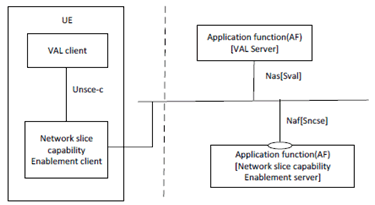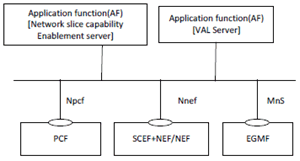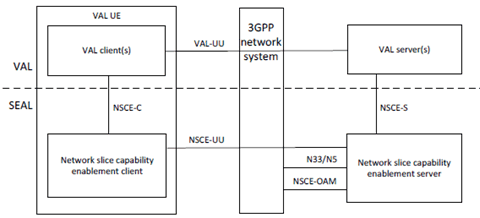Content for TR 23.700-99 Word version: 18.2.0
1 Scope
2 References
3 Definitions of terms, symbols and abbreviations
4 Application architecture for network slice capability enablement
4.1 Architectural requirements
4.2 Application architecture
4.3 Cardinality rules
...
...
1 Scope p. 7
The study identifies the SA1 requirements and potential vertical requirements of network slice capability exposure that have yet to be realized, and proposes application architecture aspects solutions and enhancements to SEAL. Based on any gaps found between requirements and existing capabilities, the present document includes: identification of key issues, solutions, corresponding evaluations and conclusions to ensure the efficient network slice capability exposure.
The study takes into consideration the SEAL architecture specified in TS 23.434, network slicing related architecture and services(such as services of NEF) specified in TS 23.501 and TS 23.502, network slicing management capability provisioning and architecture specified in TS 28.531 and TS 28.533, requirements specified in TS 22.261.
2 References p. 7
The following documents contain provisions which, through reference in this text, constitute provisions of the present document.
- References are either specific (identified by date of publication, edition number, version number, etc.) or non-specific.
- For a specific reference, subsequent revisions do not apply.
- For a non-specific reference, the latest version applies. In the case of a reference to a 3GPP document (including a GSM document), a non-specific reference implicitly refers to the latest version of that document in the same Release as the present document.
[1]
TR 21.905: "Vocabulary for 3GPP Specifications".
[2]
TS 23.434: "Service Enabler Architecture Layer for Verticals (SEAL); Functional architecture and information flows".
[3]
TS 23.501: "System architecture for the 5G System (5GS)"
[4]
TS 23.502: "Procedures for the 5G System (5GS)".
[5]
TS 28.531: "Management and orchestration; Provisioning".
[6]
TS 28.533: "Management and orchestration; Architecture framework".
[7]
TS 22.261: "Service requirements for the 5G system".
[8]
TS 28.532: "Management and orchestration; Generic management services".
[9]
TR 22.835: "Study on enhanced access to and support of network slices".
[10]
TS 28.545: "Management and orchestration; Fault Supervision (FS) ".
[11]
TS 28.535: "Management and orchestration; Management services for communication service assurance; Requirements".
[12]
TS 28.552: "Management and orchestration; 5G performance measurements".
[13]
TS 28.550: "Management and orchestration; Performance assurance".
[14]
TS 28.541: "Management and orchestration; 5G Network Resource Model (NRM); Stage 2 and stage 3".
[15]
TS 28.104: "Management and orchestration; Management Data Analytics".
[16]
TS 32.111-1: "Management and orchestration; Fault management, Part 1: 3G fault management requirements".
[17]
TS 23.288: "Architecture enhancements for 5G System (5GS) to support network data analytics services".
[18]
TS 22.263: "Services and System Aspects; Service requirements for video, imaging and audio for professional applications (VIAPA)".
[19]
TS 26.114: "IP Multimedia Subsystem (IMS); Multimedia Telephony; Media handling and interaction".
[20]
TS 23.222: "Functional architecture and information flows to support Common API Framework for 3GPP Northbound APIs; Stage 2".
[21]
TS 33.434: "Security aspects of Service Enabler Architecture Layer (SEAL) for verticals".
[22]
TS 29.536: "5G System; Network Slice Admission Control Service; Stage 3".
[23]
TS 32.404: "Performance Management (PM); Performance measurements; Definitions and template".
[24]
TS 28.554: "Management and orchestration ; 5G end to end Key Performance Indicators (KPI)".
3 Definitions of terms, symbols and abbreviations p. 9
3.1 Terms p. 9
For the purposes of the present document, the terms given in TR 21.905 and the following apply. A term defined in the present document takes precedence over the definition of the same term, if any, in TR 21.905.
3.2 Symbols p. 9
For the purposes of the present document, the following symbols apply:
3.3 Abbreviations p. 9
For the purposes of the present document, the abbreviations given in TR 21.905 and the following apply. An abbreviation defined in the present document takes precedence over the definition of the same abbreviation, if any, in TR 21.905.
ASP
Application Service Provider
Auto-NS-LCM
Automatic Application Layer Network Slice Lifecycle Management
EDN
Edge Data Network
EGMF
Exposure Governance Management Function
GST
Generic Network Slice Template
KPI
Key Performance Indicator
KQI
Key Quality Indicator
MnS
Management Service
NEF
Network Exposure Function
NEST
Network Slice Template
NOP
Network Operator
NSCE
Network Slice Capability Enablement
NSaaS
Network Slice as a Service
NSI
Network Slice Instance
NSSI
Network Slice Subnet Instance
NWDAF
Network Data Analytics Function
NSACF
Network Slice Admission Control Function
NSC
Network Slice consumer
NSP
Network Slice Provider
NSMF
Network Slice Management Function
OAM
Operation, administration and maintenance
QoE
Quality of Experience
S-NSSAI
Single Network Slice Selection Assistance Information
VAL
Vertical Application Layer
4 Application architecture for network slice capability enablement p. 10
4.1 Architectural requirements p. 10
4.1.1 General requirements p. 10
[AR.4.1.1-a]
The application enablement layer shall support interaction with 3GPP network management system to consume network slice management service.
[AR-4.1.1-b]
The NSCE architecture shall support one or more applications from the same vertical.
[AR-4.1.1-c]
The NSCE client shall be able to communicate to multiple NSCE servers.
[AR-4.1.1-d]
The API interactions between the vertical application server(s) and NSCE server(s) shall conform to CAPIF as specified in TS 23.222.
[AR-4.1.1-e]
The NSCE server(s) shall provide a service API compliant with CAPIF as specified in TS 23.222.
4.1.2 Security requirements p. 10
[AR-4.1.2-a]
The application architecture shall provide mechanisms to authorize the usage of network slicing related services by the VAL servers and NSCE clients.
[AR-4.1.2-b]
The application architecture shall support mutual authentication and authorization check between clients and servers, servers and servers that interact.
4.1.3 Registration requirement p. 10
[AR.4.1.3-a]
The application layer architecture shall provide mechanisms for an VAL server to register onto the NSCE servers.
4.1.4 Discovery requirement p. 10
[AR.4.1.4-a]
The application layer architecture shall provide mechanisms for the discovery of NSCE services exposure to the VAL server.
4.1.5 Lifecycle management requirement p. 10
[AR.4.1.5-1]
The application layer architecture shall provide a mechanism for lifecycle management of network slice to VAL server.
[AR.4.1.5-2]
The application layer architecture shall provide a mechanism for lifecycle management of network slice communication service to VAL server.
4.1.6
[AR.4.1.6-1]
The application layer architecture shall provide a mechanism to the VAL server to compare between the requested and actual slice QoS.
[AR.4.1.6-2]
The application layer architecture shall provide a mechanism to support aggregation of slice performance information retrieved from all applicable sources.
[AR.4.1.6-3]
The application layer architecture shall provide a mechanism to the VAL server to retrieve that aggregated slice performance data.
4.2 Application architecture p. 11
4.2.1 General p. 11
This clause provides the overall architecture description:
- Clause 4.2.2 describes the application architecture in the service based representation and reference point representation;
- Clause 4.2.3 describes the functional entities;
4.2.2 Architecture p. 11

Figure 4.2.2-1: Architecture for network slice capability enablement - Service based representation
(⇒ copy of original 3GPP image)
(⇒ copy of original 3GPP image)
Figure 4.2.2-1 exhibits the service-based interfaces for providing and consuming network slice capability enablement services.
The mechanisms for service discovery in the service-based representation depicted in Figure 4.2.2-1 are as follows:
- The network slice capability enablement server could provide service to VAL server and NSCE client through interface Snsce.

Figure 4.2.2-2: Architecture for network slice capability enablement utilizing the 5GS network services based on the 5GS SBA - Service based representation
(⇒ copy of original 3GPP image)
(⇒ copy of original 3GPP image)
Figure 4.2.2-3 depicts the network slice capability enablement architecture in the non-roaming case, using the reference point representation showing how various entities interact with each other.

Figure 4.2.2-3: Architecture for network slice capability enablement - reference points representation
(⇒ copy of original 3GPP image)
(⇒ copy of original 3GPP image)
The network slice capability enablement client communicates with the network slice capability enablement server over the NSCE-UU reference point. The network slice capability enablement client provides the support for network slice capability enablement functions to the VAL client(s) over NSCE-C reference point. The VAL server(s) communicates with the network slice capability enablement server over the NSCE-S reference point. The network slice capability enablement server, acting as AF, may communicate with the 5G Core Network functions via NEF (N33) reference point (for interactions with PCF, NSACF, etc.), or interacting with PCF directly via N5, if permitted. The network slice capability enablement server may interact with OAM system over NSCE-OAM reference point, as consumer in both NSaaS and NoP model (for Network Slice Provisioning capabilities, Performance Assurance, Fault Supervision etc.).
Figure 4.2.2-4 illustrates the architecture for interconnection between NSCE servers.

The NSCE server could interact with another NSCE server over NSCE-E reference point.
4.2.3 Functional elements p. 13
4.2.3.1 Network slice Capability Enablement client p. 13
The network slice capability enablement client functional entity acts as the application client for the slice enablement. The network slice capability enablement client interacts with the network slice capability enablement server to trigger a network slice related operations. This trigger may be due to an application QoS requirement change, a service operation change, a network slice status change, etc. The NSCE client may receive a network slice related notification from the NSCE server. The NSCE client may optionally notify the VAL client on the network slice / DNN change.
4.2.3.2 Network slice Capability Enablement server p. 13
The network slice capability enablement server functional entity provides application layer enablement to support the network slice management and control with/without invoking control and management plane capabilities from SA2 and SA5 pertaining to network slicing. Such enablement supports the network slice related operations such as the mapping or migration of one or more vertical applications to one or more network slices, triggering the dynamic network slice lifecycle management, NSI/NSSI monitoring, etc.
4.2.4 Service-based interfaces p. 13
The architecture for enabling network slice capability enablement service contains the following service-based interfaces:
Sval:
Service-based interface exhibited by VAL server.
Snsce:
Service-based interface exhibited by NSCE server.
Unsce-c:
Service-based interface exhibited by NSCE client.
4.2.5 Reference points description p. 13
4.2.5.1 VAL-UU p. 13
The interactions related to vertical application layer support functions between VAL client and VAL server are supported by VAL-UU reference point. This reference point is an instance of Uu reference point as described in TS 23.401 and TS 23.501.
4.2.5.2 NSCE-UU p. 14
The interactions between a NSCE client and the corresponding NSCE server are generically referred to as NSCE-UU reference point. This reference point supports fault data, QoE data and KQI data provisioning etc.
4.2.5.3 NSCE-C p. 14
The interactions between the VAL client(s) and the NSCE client(s) within a VAL UE are generically referred to as NSCE-C reference point. This reference point supports obtaining information about network slice that VAL client(s) require, application client information (such as its KQI) provisioning etc.
4.2.5.4 NSCE-S p. 14
The interactions between the VAL server and the NSCE server are generically referred to as NSCE-S reference point. This reference point supports network slice capability exposure such as: application layer slice lifecycle management, fault diagnosis, slice API configuration and mapping, QoS verification, slice performance analytics exposure etc.
4.2.5.5 NSCE-E p. 14
The interactions between the NSCE servers are generically referred to as NSCE-E reference point. his reference point supports information collection from other NSCE servers.
4.3 Cardinality rules p. 14
4.3.1 General p. 14
The cardinality rules are applied to the architecture specified in clause 4.2. The cardinality rules are based on functional elements. The functional elements cardinality specifies the multiplicity of the functional elements that can exist as per the architecture.
4.3.2 Functional Entity Cardinality p. 14
4.3.2.1 VAL Client p. 14
The following cardinality rules apply for VAL Clients:
- One or more VAL Clients may be located in a UE.
4.3.2.2 NSCE Client p. 14
The following cardinality rules apply for NSCE Clients:
- One or more NSCE Client(s) may be located in a UE.
4.3.2.3 NSCE Server p. 14
The following cardinality rules apply for NSCE Server:
- One or more NSCE Server(s) may be located in an PLMN; and
- One or more NSCE Server(s) may be located in an PLMN per Network slice Provider.
4.3.2.6 VAL Server p. 14
The following cardinality rules apply for VAL Servers:
- One or more VAL Server(s) may be served by one NSCE server.
4.3.3 Service Cardinality p. 15
- One NSCE server may enable one or more Network slice(s) identified by S-NSSAI(s);
- One Network slice can only be enabled and served by one NSCE server.
- The NSCE servers may provide service in the same or in different Tracking Areas.